 MAIN ECONOMIC FIGURES MAIN ECONOMIC FIGURES |
All the information found within this section is sole responsibility of FUNDESA (Guatemalan Development Foundation)
 Country Profile Country Profile |
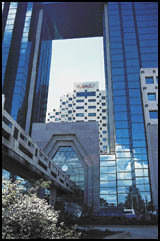
Official name: Republic of GuatemalaCapital: Guatemala CityHead of state: President Alfonso Portillo Next
Presidential elections: 2004
Currency: Quetzal (Q)
Official language: Spanish
Area: 108,890 square kilometers, (42,042 square miles).
Principal urban centers: Guatemala City, Quetzaltenango, Escuintla, Cobán, Chichicastenango and Puerto Barrios.
Topography: Mostly mountainous with narrow coastal plains.
Climate: Two predominant seasons; wet (May through October) and dry (November through April). Temperatures are moderate year round.
Demographic statistics Total Population: 11.3 millionRural population: 51.8 percentPercentage of males: 49.3Annual rate of growth: 2.64Life expectancy: 64.6 yearsPopulation density: 112 per square mileAdult literacy rate: 63.3 percent
Principal economic indicators Gross Domestic Product (GDP): US$18.3 billion (Largest in Central America)GDP growth rate: 3.6 percentGDP per capita: US$1,475.00External debt: US$1.42 billionLabor force: 4.3 millionInter-annual accumulated inflation: 4.9 per cent Exchange rate: US$1.00= Q7.80 (Rate floats freely)Time zone: EST -1 hour, GMT minus 6 hours
National public holidays: January 1, Holy Thursday, Holy Friday, May 1, June 30, August 15 (Guatemala City only), September 15, October 20, November 1, December 24 (half day) and December 25.
 Region 1 Region 1 |
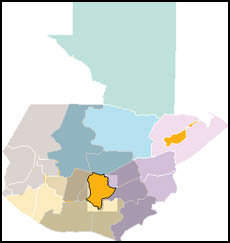
 Metropolitan Guatemala Metropolitan Guatemala |
Department: Guatemala
Population: 2,578,526
Area: 2,126 square kilometers
Average temperatures: 15-26°C
Annual projected rainfall: 1,256 mm
Mean altitude: 1,500 meters
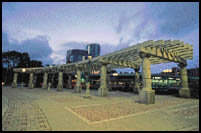
Principal urban centers: Guatemala City, Mixco, Villa Nueva, and Amatitlán.
Protected areas: Pacaya Volcano, Kaminal Juyú Archaeological Center and the Hipódromo del Norte Relief Map.
Principal agricultural products:Corn, coffee, carrots, and apples.
Products with growth potential: Snow peas, broccoli, cut flowers, and bromeliads.
Principal industries: Light manufacturing, food processing, beverage bottling plants, retail, textile and clothing assemblage plants (drawback), and packaging of agro-industrial products.
Mineral deposits in the region: Antimony, barium, zinc, iron and manganese.
Infrastructure:
Hotel rooms available: 4,875
Homes with electricity: 92%
Telephone lines per 1,000 inhabitants: 88.2
Pay telephones: 2,500
AM Radio Stations: 31
FM Radio Stations: 49
Commercial TV Stations: 8
Public health facilities: 16
Private health facilities: 168
Public education institutions: 287
Private education institutions: 410
 Region 2 Region 2 |
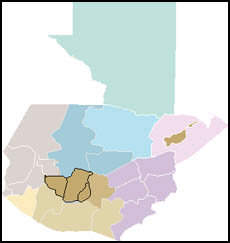
 Central Highlands Central Highlands |
Departments: 2 Chimaltenango, 3 Sacatepéquez and 4 Sololá.
Population: 994,658
Area: 3,505 square kilometers
Average temperatures: 18-24°C
Annual projected rainfall: 952 - 1,587 mm
Mean altitude: 1,530 - 2,114 meters
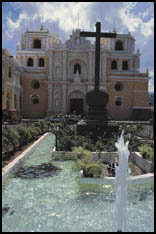
Principal urban centers: Chimaltenango, La Antigua Guatemala, Sololá and Panajachel.
Protected Areas: The city of La Antigua Guatemala, Lake Atitlán Multe Area, Iximché Monument, San Pedro, Acatenango, Fuego and Agua Volcanoes.
Principal agricultural products: Coffee, corn, wheat, baby vegetables, cut flowers, and fruits.
Agricultural products with growth potential:Okra, melon and garlic.
Principal industries: Drawback textile operations, hand-woven textiles, non-traditional vegetables packaging plants, and regional handicrafts.
Mineral deposits in the region: Antimony, iron, titanium and copper.
Access: The Inter-American Highway provides primary access to the region year-round.
Infrastructure: Hotel rooms available: 2,630
Homes with electricity: 72.7 percent
Telephone lines per 1,000 inhabitants: 22
Pay telephones: 90
AM Radio Stations: 32
FM Radio Stations: 61
Public health facilities: 7
Private health facilities: 22
Public education institutions: 20
Private education institutions: 23
 Region 3 Region 3 |
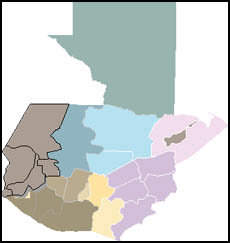
 Western Highlands Western Highlands |
Departments: 5 Quetzaltenango, 6 Totonicapán, 7 San Marcos, and 8 Huehuetenango.
Population: 2,764,028
Area: 4,203 square kilometers
Average temperatures: 12 - 19°C
Annual proyected rainfall: 94 - 2,138 mm (regional average)
Mean altitude: 1,900 - 2,495 meters
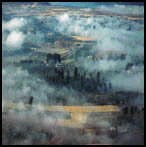
Principal urban centers: Quetzaltenango, Totonicapán, San Marcos, and Huehuetenango.
Protected areas: Tajumulco Volcano.
Principal agricultural products: Corn, wheat, coffee, fruits, and wool.
Products with growth potential: Broccoli and forest products.
Principal industries: Hand-woven and manufactured textiles, regional handicrafts for export, furniture, ceramics, and blown glass.
Principal industries: Shoe manufacturing, regional handicrafts, bromeliad plantations, and forest products.
Mineral deposits in the region: Barium, cobalt, zinc, silver, lead and titanium.
Access: The region is accessible year round by the Inter-American Highway and by the Pacific Coastal Highway.
 Infrastructure Infrastructure |
Hotel rooms available: 1,650
Homes with electricity: 53 percent
Telephone lines per 1,000 inhabitants: 19
Pay telephones: 155
AM Radio Stations: 22
FM Radio Stations: 48
Public health facilities: 14
Private health facilities: 53
Public education institutions: 52
Private education institutions: 37
 Region 4 Region 4 |
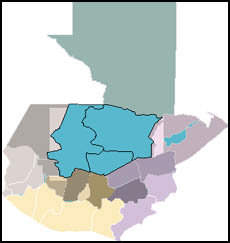
 Northern Highlands Northern Highlands |
Departments: 9 Quiché, 10 Alta Verapaz, and 11 Baja Verapaz.
Population: 1,606,561
Area: 20,188 square kilometers
Average temperatures: 16 - 22°C (in department capitals)
Annual projected rainfall: 789 - 1,265 mm (regional average)
Mean altitude: 940 - 2,021 meters
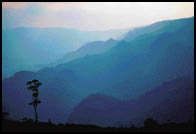
Principal UrbAn centers: Santa Cruz del Quiché, Cobán, Salamá, and Chichicastenango.
Protected areas: Sierra de las Minas Biosphere, Lachuá National Park, Mario Dary Biotope (Quetzal Biotope), Sierra de los Cuchumatanes Multiple Use Area, and Semuc Champey River Monument.
Principal agriculturalproducts: Coffee, cardamom, rice, broccoli, corn, and black pepper.
Products with growth potential: Rubber, cut flowers, garlic, and fruits.
Mineral deposits in the region: Barium, cobalt, zinc, silver, lead and titanium.
Principal industries: Shoe manufacture, regional handicrafts, bromeliad plantations, and forest products.
Access: Good road access is restricted to the cities of Salamá and Cobán in Baja and Alta Verapaz and Santa Cruz del Quiché in the Department of El Quiché.
|  Infrastructure Infrastructure |
Hotel rooms available: 990
Homes with electricity: 37.8
Telephone lines per 1, 000 inhabitants:14
Pay telephones: 60
AM Radio Stations: 7
FM Radio Stations: 18
Public health facilities: 8
Private health facilities: 4
Public education institutions: 15
Private education institutions: 16
 Region 5 Region 5 |
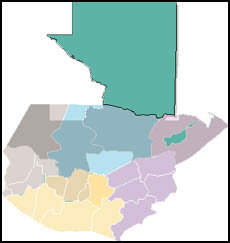
 Petén Petén |
Departments: 12 Peten
Population: 303,389
Area: 35,854 square kilometers
Average temperatures: 22 - 34°C
Annual projected rainfall: 1,270 mm
Mean altitude: 127 meters
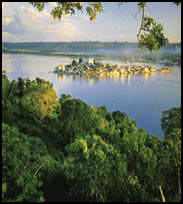
Principal urban centers: Flores
Protected areas: Maya Biosphere Reserve, Tikal National Park, Cerro Cahui Biotope, Laguna El Tigre-Rio Escondido Biotope, San Miguel-La Palotada El Zotz Biotope, and Ceibal-Aguateca-Dos Pilas Monuments.
Principal agricultural products: Corn, rice, and black beans.
Products with GROWTH potential: Black pepper and forest products.
Principal industries: Low-impact tourism, oil, precious woods, palm fronds, chicle, and wood ornaments.
Mineral deposits in the region: Copper
Access: The completion of a paved road provides adequate access to the region. Daily commercial flights from both Guatemala City and Mexico service the region.
 Infrastructure Infrastructure |
Hotel rooms available: 1,065
Homes with electricity: 38.6 percent
Telephone lines per 1,000 inhabitants: 11
Pay telephones: 25
AM Radio Stations: 5
FM Radio Stations: 4
Public health facilities: 2
Private health facilities: 3
Public education institutions: 7
Private education institutions: 3
 Region 6 Region 6 |
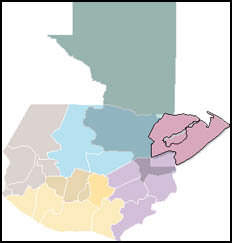
 Izabal Izabal |
Departments: Izabal
Population: 333,956
Area: 9,038 square kilometers
Average temperature: 20 - 28°C
Annual projected rainfall: 3,075 mm
Mean altitude: Sea level to 70 meters
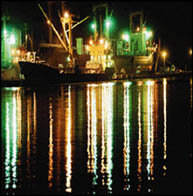
Principal urban centers: Puerto Barrios
Protected areas: Sierra de las Minas Biosphere Reserve, Rio Dulce National Park, Chocón Machacas Biotope, Punta de Manabique Biotope, Cerro San Gil, Bocas del Polochic, and Quiriguá Monument.
Principal agricultural products: Bananas, corn, black beans, rice, and plantains.
Products with growth potential: Citrus and tropical fruits.
Principal industries: Port operations, private marinas, oil pipeline terminal, fishing, and plywood manufacturing.
Access: The region's principal cities can be reached by the Inter-Oceanic Highway, which is functional year-round.
 Infrastructure Infrastructure |
Hotel rooms available: 1,035
Homes with electricity: 66.8 percent
Telephone lines per 1,000 inhabitants:19
Pay telephones: 150
AM Radio Stations: 8
FM Radio Stations: 30
Public health facilities: 13
Private health facilities: 9
Public education institutions: 31
Private education institutions: 22
 Region 7 Region 7 |
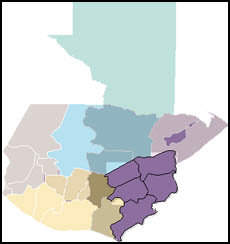
 Eastern Plains Eastern Plains |
Departments: 14 Jutiapa, 15 Jalapa, 16 Chiquimula, 17 Zacapa and 18 El Progreso
Population: 1,325,105
Area: 12,270 square kilometers
Average temperatures: 20 - 30°C
Annual projected rainfall: 1,150 mm
Mean altitude: 184 - 1,800 meters
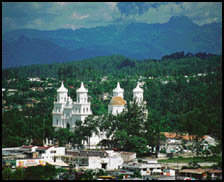
Principal urban centers: Jutiapa, Jalapa, Guastatoya, Chiquimula and Zacapa.
Protected areas: Sierra de las Minas Biosphere Reserve
Principal agricultural products: Rice, sugar cane, tobacco, cocoa, bananas, melons, okra, sesame seeds, grapes, corn, fruits, and black beans.
Products with growth potential: Vegetables and tropical fruits.
Principal industries: Cement production, agricultural fertilizers, and soft drink bottling plants.
Access: Recent improvements to the Inter-Oceanic Highway facilitate access to the region.
 Infrastructure Infrastructure |
Hotel rooms available: 1,375
Homes with electricity: 66.8 percent
Telephone lines per 1,000 inhabitants: 19
Pay telephones: 150
AM Radio Stations: 8
FM Radio Stations: 30
Public health facilities: 13
Private health facilities: 9
Public education institutions: 31
Private education institutions: 22
 Region 8 Region 8 |
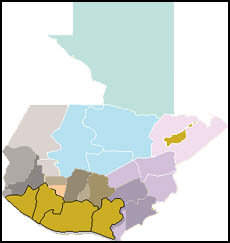
 Pacific Coast Pacific Coast |
Departments: 19 Escuintla, 20 Suchitepéquez, 21 Santa Rosa and 22 Retalhuleu
Population: 1,522,575
Area: 11,705 square kilometers
Average temperatures: 20 - 30°C (In department capitals)
Annual projected rainfall: 2,965 mm
Mean altitude: Sea level to 212 meters
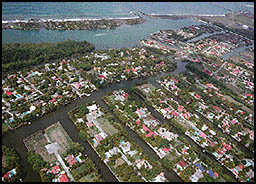
Principal urban centers: Escuintla, Mazatenango, Cuilapa, Retalhuleu, Santa Lucía Cotzumalguapa and Barberena.
Protected areas: Pacaya volcano, Hawai National Park, and Monterrico Natural Reserve.
Principal agricultural products: Sugar cane, cotton, bananas, coffee, cattle, cardamom, corn, black beans, soy beans, sesame seeds, fruits, shrimp, and rubber.
Products with growth potential: Fruits, vegetable sponge (loofah), cashews, okra, ginger, and Tabasco peppers.
Principal industries: Sugar and pepper mills, bottling plants, meat and seafood packing plants, shrimp farming, agro-chemical and fertilizer plants, distilleries, thermal power plants, vegetable oil, and petroleum refining.
Access: A new privately operated toll highway recently completed expedites access to the region, which is serviced by the Pacific Coastal Highway year-round.
 Infrastructure Infrastructure |
Hotel rooms available: 1,280
Homes with electricity: 68.9 percent
Telephone lines per 1,000 inhabitants: 16
Pay telephones: 125
AM Radio Stations: 12
FM Radio Stations: 32
Public health facilities: 11
Private health facilities: 9
Public education institutions: 21
Private education institutions: 25.
all these informations are provided by courtesy of Destination Guatemala and Sol y Luna |

